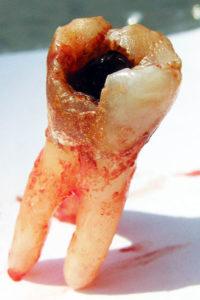Guest post by Gary M. Verigin, DDS, CTN
Did you hear the one about the new “chemical” that’s supposed to make teeth “cavity-proof”?
The chemical was designed by dentists in Chile, and wipes out all the bacteria that cause cavities in just 60 seconds in tests.
The chemical targets ‘streptococcus mutans’, the bacteria that turns the sugar in your mouth into lactic acid which erodes tooth enamel.
If only it were that simple.
But to start with, “killing germs” is kind of an antique concept. As Dr. Erwin writes,
The human mouth alone contains an estimated 10 billion bacteria. Yet most of us grow up thinking that a “clean” mouth is a germ-free mouth. As professor of oral microbiology Dr. Phillip Marsh puts it,
What we’ve been brought up with is “Plaque is bad – get rid of it.” But it’s actually too much plaque and plaque in the wrong places that are bad for us. We want to prevent the buildup of levels of organisms, particularly in hard-to-reach places of the mouth, that could lead to disease. Pushing to have an ultraclean mouth isn’t beneficial to us; we should be trying to maintain our natural microbiota at levels compatible with oral health in order to preserve their beneficial activities.
Dr. Aaron Weinberg, dean of the School of Dentistry at Case Western Reserve, agrees:
You don’t want a sterile mouth; you want a mouth that has primarily good bacteria in it, in order to keep exogenous microorganisms out and prevent them from colonizing the mouth.
Seems common sense, doesn’t it? Keep the good, control the bad. And that’s what dental hygiene is really about: not eliminating but controlling bacteria, especially those that contribute to tooth decay and gum disease.
Yet, as our regular readers and clients know, hygiene is just a part of it.
For it’s not just sugar or strep or other bacteria that causes decay. Teeth are connected to the rest of the body, and each tooth is directly connected to specific organs and systems. All structures along the same meridian – the energetic pathway that joins them – can affect and are affected by each other.
In this respect, tooth decay isn’t just something that arises from conditions in the mouth. Consider blood chemistries. Dentist Dr. Melvin Page found that when calcium drops below 9.5 and phosphorus, below 3.6, the chance of decay is greatly increased – a finding that was later independently confirmed. This imbalance is related to endocrine function, protein and carbohydrate metabolism.
Fact is, we already have the power to control and prevent decay: by making healthful choices that support and sustain the body’s self-regulating capability.
But you can’t patent, package and market that.
And so people press on with the idea that “chemicals” are always the better solution. Many patients we see in our office are living proof that they’re not.
Once upon a time, fluoride was the miracle drug. All were assured it would stop decay. Dentists painted it on teeth. Manufacturers put it in toothpastes. Cities put it in their water supply.
 And what happened?
And what happened?
Originally published on Know Thy Health. Gratefully used with permission.